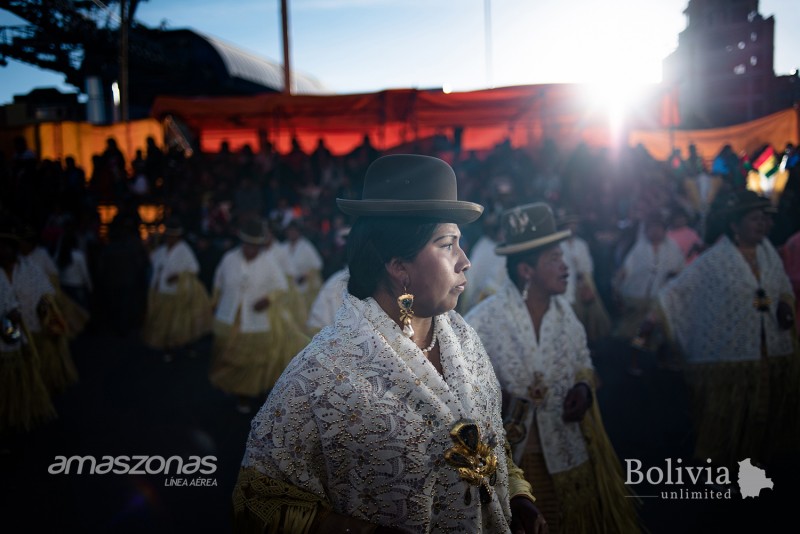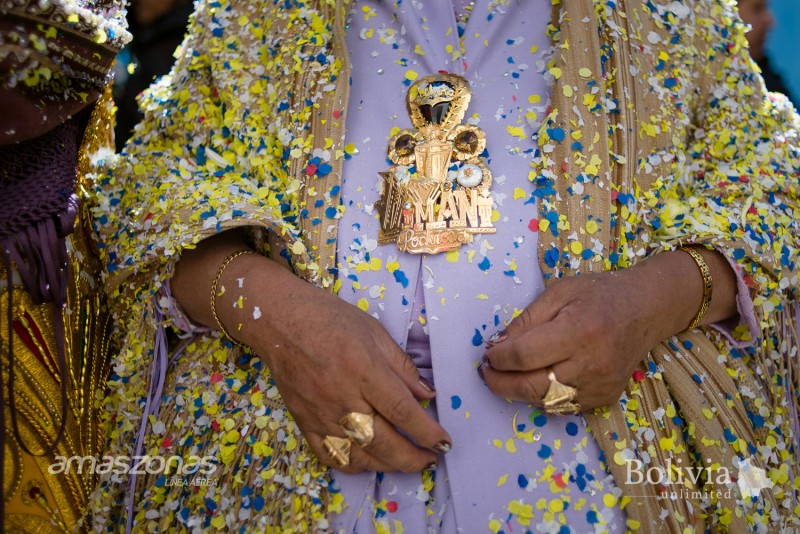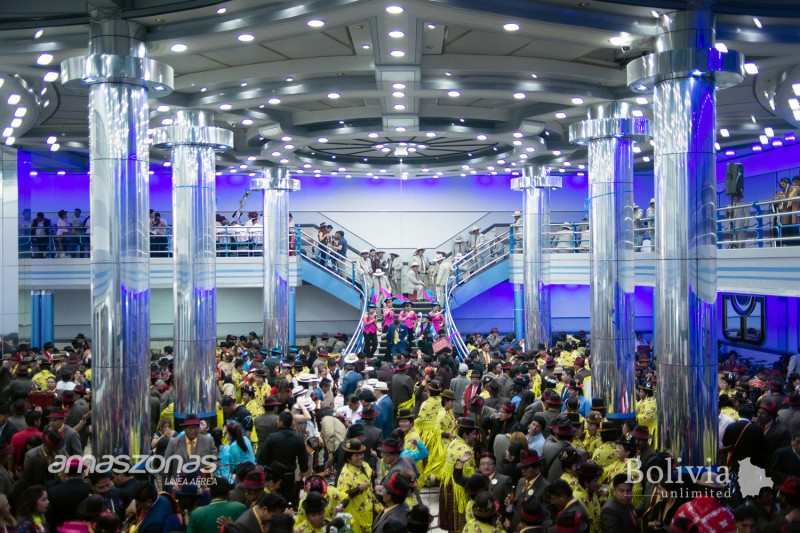The legitimisation and consolidation of the qamiris

03 Jan, 2020 | Caroline Risacher
Social issues, Lifestyle and Culture
Photos: Manuel Seoane
The Aymara business elite in modern Bolivia
Just 15 years ago, Aymara, Quechua and other indigenous people in Bolivia regularly suffered open discrimination, including being barred from entering certain businesses and being generally looked down by the mestizo-criollo elite. In the last decade, though, racist stereotypes have diminished drastically with the appearance of an Aymara business elite, whose success and visibility are epitomised by the colourful and extravagant cholets of the indigenous-majority city of El Alto, buildings which exhibit a neo-Andean architectural style characterised by geometrical lines and vibrant colors.
The last 14 years in Bolivia have been defined by a process of change led by the recently deposed Bolivian president Evo Morales (the first indigenous leader of the country). During his tenure, Bolivia recorded an average GDP growth rate of 4.8 percent, attesting of the success and stability of Morales’s presidency, which has used the upward mobility of the indigenous middle class as evidence of its policies’ success. Current events notwithstanding—in which a right-wing interim government is trying to consolidate its newly gained power after a disputed election—it would seem difficult after the advances gained by the indigenous majority for it to lose this cultural recognition and acceptance.
However, as sociologist Pablo Mamani of the Universidad Pública de El Alto (UPEA) explains, this elite ‘[is] not a product of Evo; they have always existed. They are more visible now.’ According to sociologist Gustavo Adolfo Calle, a member of Jiccha, an Indianista-Katarista collective, in the last 15 years ‘the emergence of a social class with an indigenous face allowed large-scale social mobility in Bolivia, giving way to the structuring of social classes within the indigenous world that broke with the apparent homogeneity that characterised them.’
‘The emergence of a social class with an indigenous face allowed large-scale social mobility in Bolivia, giving way to the structuring of social classes within the indigenous world that broke with the apparent homogeneity that characterised them.’
—Gustavo Adolfo Calle
This social category is often referred to as an Aymara ‘bourgeoisie’, an accurate enough term if using the broader definition of the word as its members are clearly of the middle class. But the Marxist connotation of ‘bourgeoisie’ doesn’t apply to this social group, as this elite doesn’t own the means of production and is not yet particularly concerned with acquiring them. The word ‘elite’ is closer to capturing the essence of this group, but it, too, doesn’t fit perfectly, as there is no sense of superiority in terms of ability or qualities compared with the rest of society. Additionally, there is still a deep sense of internalised colonialism within Bolivian society, in which the criollo-mestizo classes remain the traditionally recognised elites.
The term Bolivian sociologists prefer to use to define this emerging upper social class comprising Aymara-Quechua bourgeois businesspeople is qamiri, an Aymara word used to describe someone with money and influence and the capacity to share their status and wealth. This follows the Aymara notion of ayni—reciprocity between individuals—that is central to relations in Andean society. Ayni allows the indigenous elite to convert their economic capital into prestige and social capital. By redistributing their earnings, they generate social capital and establish new economic ventures. This allows qamiris to gain and expand control of spaces that were once monopolised by the criollo-mestizo elite.
The defining characteristic of the qamiris, according to sociologist Tania Quilali, who investigated qamiris during the Gran Poder celebration in La Paz, is that they hold ‘economic, social, cultural and symbolic capital.’ However, there is no consensus on how much financial success one needs to become a qamiri. According to Quilali, the threshold is US $2,000 per month. For Mamani, someone who employs at least 10 workers can be considered a qamiri, or owning a property worth at least half a million dollars. Qamiris are also expected to be able to independently organise and finance traditional parties, as opposed to those who simply borrow money to hold these parties in order to gain social influence and strike up business relations. (According to Quilali, these parties normally cost at least US $30,000 to $40,000.)

These parties, such as those held during the Gran Poder festivities, are central to the qamiri identity, notably in the form of prestes, a type of communitarian celebration given by pasantes (sponsors, usually qamiris), which typically honor a saint. Prestes are frequently accompanied with folkloric dancing parades, and they are large celebrations in which no expenses are spared. But celebrations that qamiris finance and partake in are not limited to prestes; they also include weddings, building-inauguration and business-opening ceremonies, and anniversaries. According to Quilali, a socially active qamiri will attend on average about two to three parties per month.
These celebrations serve as spaces in which qamiris can flaunt their money, exhibiting their financial acumen and success, and where they can make new contacts to expand business opportunities and form connections and consolidate their social and business relations. Particular attention must be made to impress celebrants. As Quilali describes, ‘The clothes used are expensive, the garments must be fashionable and modish, shoes must have a special design and outfits are never to be repeated. Women will wear vicuña wool scarves, as well as gold and silver jewels.’

But the garishness of these celebrations is contrasted by the modest and unpretentious daily lives of qamiris, who generally eschew demonstrating any external signs of wealth. They use public transportation and wear the same clothes and eat the same street food as everyone else in their community. There is no overwhelming push to distinguish themselves outside of the parties. For Mamani, the reasons are social and cultural. ‘There is a saying in Aymara—“Don’t be like the q’ara”—don’t be like the white men. Don’t exploit others and don’t behave haughtily.’
'Qamiris use public transportation and wear the same clothes and eat the same street food as everyone else in their community. There is no overwhelming push to distinguish themselves outside of the parties.'
Qamiris came to the attention of academics in the 1980s, when the informal economy in Oruro, another large city on the Bolivian altiplano, experienced a boom following the creation of a free-trade zone in the port of Iquique, Chile, and local Aymara traders amassed fortunes importing, sometimes illegally, merchandise into Bolivia. According to Mexican sociologist Carmen Rea Campos in her 2015 paper ‘Cuando la otredad se iguala. Racismo y cambio estructural en Oruro (Bolivia)’, this indigenous elite ‘is the unexpected and unintended result of the economic crisis of the 1980s, the flexible labor market of the 1990s, the expansion of Asian trade in the national economy and, above all, the ability of these agents to translate, reinterpret and articulate two rationalities regarded as opposites: the traditional-emotional and the pragmatic.’ But for Bolivian anthropologist Jorge Llanque, who has investigated the qamiri elites in Oruro, this growth of the qamiri class was part of an inevitable process: ‘This elite has not emerged spontaneously; on the contrary, it is the product of historical relations consolidation in the western border area from the department of Oruro.’ Essentially, qamiris are the result of the revolutionary nationalism of the late 1960s (a consequence, in part, of the 1952 National Revolution), the subsequent rise of Katarismo and Indianismo (ethnic- and class-solidarity movements originating in the late 1960s that still wield enormous political heft today), the structural neoliberal changes in the 1980s under right-wing dictatorship and governments, and the more recent expansion of Chinese business interests in the national market.
The existence of qamiris is the result of a long social and historical process that started three or four generations ago, with each new generation building on the previous one to grow its economic capital. For instance, ‘In La Paz we are seeing processes that took three to four generations. The grandfather had a small import business from Chile. The son improved on this business, and the grandson amplified it and thrives now doing business with China,’ Mamani says. ‘However, it is not a homogeneous group; their social and financial capital can vary greatly, with the richest qamiris’ worth being valued up to US $3 million.’
Additionally, central to the formation process and the construction of a qamiri identity is the migrant route from rural to urban areas, which plays a defining role as traditional Aymara concepts are transposed and then adapted to urban living. If ayni is the notion of reciprocity between individuals, ayllu involves groups of people (families, communities). But it is not just about reciprocity and harmony. Embedded in aylluis a very competitive rivalry between these groups in order to show competing groups which has the most wealth. According to the Aymara sociologist Jesus Humerez of UPEA, this concept of ayllu explains how the economic success of businessmen is based on competitiveness amongst themselves in regards to resources and social capital. But if in the countryside wealth is measured on how many sheep an individual owns, in the city the emphasis is placed on the social abilities and social capital of an individual.

The ability to create vast social networks is the key to the success of the modern qamiri. The range and tightness of these networks forge solid business relations and confer upon the qamiri a reputation and prestige that can’t be bought with money. These are not just local networks, as they can extend to other countries too, notably China, Argentina, Brazil and Chile. China is a very lucrative market for Aymara traders, who regularly travel there to buy tens of thousands of dollars’ worth of merchandise. Alfonso Hinojosa, a sociologist and specialist on migration at the University of San Simon in Cochabamba, says that the commercial bond between Aymara and Chinese businessmen is so strong that some Chinese sellers tailor their products to Bolivian tastes, and it is not uncommon for qamiris to send a relative to live in China. ‘There is even a cholet in El Alto whose style is reminiscent to a Chinese pagoda,’ Hinojosa says.
The same is true in other South American countries and across Bolivia. Qamiris, through family and social connections, create local, national and international networks that bring economic and social prestige to themselves. And here is another reason for the success of the Aymara businessmen: the capacity to use and adapt traditional values of reciprocity and competitiveness in order to thrive in the modern capitalist world order. As summarised by Hinojosa, the secret to this success includes the following three factors: ‘control of a determined geographical space, versatility in business ventures, and the ability to create solid networks on large scales.’
'Here is another reason for the success of the Aymara businessmen: the capacity to use and adapt traditional values of reciprocity and competitiveness in order to thrive in the modern capitalist world order.'
The logical next step for a social class experiencing upward social mobility and accumulating capital would be to consolidate this power by acquiring political influence. This hasn’t happened yet, as the qamiri social group is not affiliated with any of the current political parties in Bolivia. ‘They don’t join political parties, but they think about their group,’ says Pablo Mamani. Jesus Humerez echoes this sentiment. ‘There are sectors who know about politics, but they are not interested in it,’ he says. ‘They have their business and as long as politics are not affecting them they will continue doing what they do. Maybe if a new political context affects [them] they will reconsider it.’ Humerez says that it’s not that qamiris have absolutely no interest in politics, but that they have deep ideological differences with political leaders. ‘Evo Morales is a syndicalist,’ he says. ‘He sells a socialism for the 21st century, a state socialism, and [the qamiris] are going in another direction; they are looking for another way [to enter politics].’
Qamiris are often asked about their involvement in politics and why they don’t invest in larger projects such as universities, banks or TV stations, Pablo Mamani says. ‘It is hard for them to answer,’ he says. ‘One of the reasons is that they don’t want to wait to receive a return on their investment. And it could also be mistrust in the system or a lack of knowledge on how to invest money and how banks work.’ For Jesus Humerez, a recurring factor is the absence of dialogue between qamiris and the intellectual new wave of Aymara thinkers. ‘A common vision cannot emerge,’ he says, ‘until academics and intellectuals sit down together and build a project with a common vision. What is missing is a state vision.’ Pablo Mamani shares a similar sentiment after asking qamiris various questions such as ‘How do you envision your city in the future?’ ‘How do you imagine it should be?’ He says that the qamiris he interviewed mentioned improvements to their neighbourhoods, but very few mentioned improving the city as a whole, and even fewer had national ambitions. This lack of vision, which impedes any successful political participation, may have deep roots but preclude any desire to engage in politics.
‘What I’ve seen is that they would rather not enter politics because of the risks [to their economic capital],’ Jesus Humerez says. ‘But yes, they think about politics. They want to take the power but, as Aymara, they don’t consider that they could do it. I still hear people saying that they are not capable to be ministers, deputies, to have high positions of power. There is still a complex of inferiority. For historical and ideological reasons. We have to break this so our people can believe that they can rule this country.’ This complex of inferiority, or internalised colonialism, as Tania Quilali and Pablo Mamani call it, is still very present and can manifest itself in two ways. According to Mamani, ‘There are two tendencies, either become “whiter,” or move to new neighborhoods, which implies a retaking of these [criollo-mestizo] spaces and a rivalry to dominate them.’

For Tania Quilali, this internal colonialism is so deeply ingrained that ‘the qamiris seek recognition in parties because, despite having economic capital, they cannot be part of the traditional bourgeoisie in La Paz.’ Because of this internal colonialism, being of Aymara origin itself is still a disadvantage despite the fact that many qamiris have capital equal to or greater than that of the traditional upper class of La Paz. They will never be acknowledged as equals to the traditional criollo-mestizo elite. Qamiris are still ‘indigenous’, ‘brown’, ‘peasants’, ‘without education’ and ‘folklorists’ (in a derogatory sense). What Quilali describes is not a reflection of how all criollo-mestizos see qamiris, but instead how qamiris think they are perceived and how they see themselves. Racism is still very much present in Bolivia, but the internal colonialism affects the ethos of a class and prevents them from entering a more elevated position in the larger Bolivian society.
It is not clear what direction the children of qamiris will take. Some of them are now attending private universities and share spaces with the children of the criollo-mestizo elite, which can lead to a rejection of their family values and businesses. ‘The children don’t necessarily want to follow in their parent’s footsteps,’ Tania Quilali says. ‘They want to learn English, travel abroad, and would rather live a different lifestyle closer to the ones of the white elite.’ But she observes that, perhaps years after this initial rejection of the qamiri lifestyle, the children might still take over their parent’s businesses once they realise the financial advantages of doing so.
Qamiris have gained visibility under Evo Morales, and they have established themselves as a social class with power and influence which they demonstrate during celebrations, by moving to neighborhoods normally associated with the criollo-mestizo elite, and by commissioning buildings each time more grandiose than the previous one. At the moment, and especially in this uncertain political and social context, we can only guess how Bolivian society will look like in a few years. Will the country move past racial cleavage and turn into a society divided along social classes? How will traditions and language be passed down to the next generation? Bolivia has changed enormously in the last 15 years, and that is no small part due to the consolidation and legitimation of the qamiris as a new social stratum. The changes that have and are happening are part of a process that started long before Evo Morales took power in 2005, going back to the 1952 National Revolution, if not before then but in a more inchoate manner. The emergence of the Aymara elite and the differentiation of social classes among Bolivian indigenous groups are representative of a social and cultural shift that will have repercussions for the whole of Bolivian society. ‘The changes are irreversible,’ says Pablo Mamani, concluding that ‘things are going to keep advancing, and as these groups will become more politicised, that will lead to a global social, economic and symbolic reform.’








